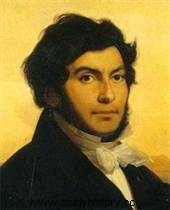 French Jean-François Champollion is one of the most famous Egyptologists of the 19th century. Producing the first scientific system of deciphering hieroglyphs , the one who said "I am everything for Egypt and it is everything for me" will have marked history (and not only as a discipline). A child of the Revolution and the Egyptian expedition, Champollion contributed in his own way to the establishment of a special relationship between Paris and Cairo, which two centuries later still persists. Prince of the Egyptophiles, his essential work is still visible in Paris, with a certain obelisk, Place de la Concorde...
French Jean-François Champollion is one of the most famous Egyptologists of the 19th century. Producing the first scientific system of deciphering hieroglyphs , the one who said "I am everything for Egypt and it is everything for me" will have marked history (and not only as a discipline). A child of the Revolution and the Egyptian expedition, Champollion contributed in his own way to the establishment of a special relationship between Paris and Cairo, which two centuries later still persists. Prince of the Egyptophiles, his essential work is still visible in Paris, with a certain obelisk, Place de la Concorde...
Jean-François Champollion, genius of ancient languages
Jean-François Champollion was born on December 23, 1790 in Figeac. His bookseller father, originally from Isère, displayed pro-revolutionary ideas, even favorable to the Jacobins. Seventh child of the family, Jean-François stood out for his keen intelligence. Legend has it that he learned to read alone among the books in his father's shop. A child with a volcanic temperament, he did not always fit easily into the school system, but benefited from the support of his older brother:Jacques-Joseph.
The latter, passionate about history and archeology, sensed the full potential of his younger brother. Highly visible among the elite of Grenoble (he will befriend Fourier but also Berriat) where he resides, he brought Jean-François to the capital of the Alps to take charge of his education. The young prodigy proves to be too gifted for his master brother, who entrusts him to an abbot. It was at this time that the future Egyptologist learned Latin and Greek, but also Hebrew, Arabic, Syriac and Chaldean. In 1804 Jean-François joined the imperial high school in Grenoble (the current Stendhal high school) after having passed the competition brilliantly.
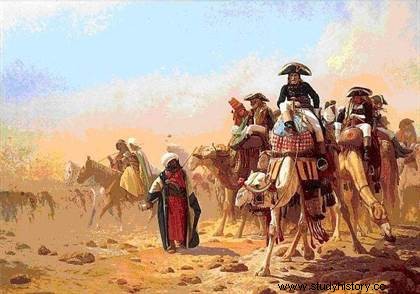 If he hardly recognizes himself in the militarized organization of the establishment, he flourishes there on intellectually, deepening his knowledge of ancient languages and embarking on his first research. His brother who worked on the famous "Description of Egypt" (the collection of research and their results, carried out during the Egyptian Expedition of 1799), as well as a meeting with a Greek monk passionate about the country of the Pharaohs urge him to look into the mysterious hieroglyphs.
If he hardly recognizes himself in the militarized organization of the establishment, he flourishes there on intellectually, deepening his knowledge of ancient languages and embarking on his first research. His brother who worked on the famous "Description of Egypt" (the collection of research and their results, carried out during the Egyptian Expedition of 1799), as well as a meeting with a Greek monk passionate about the country of the Pharaohs urge him to look into the mysterious hieroglyphs.
At barely 15 years old, Jean-François set himself the task of making a complete study of them, fascinated as he is by the centuries-old civilization that spawned them. In 1807, he left Grenoble (not without having dazzled his Academy of Sciences) for Paris where he hoped to find the resources necessary for his work. A student at the Collège de France, he is still perfecting his language skills. Convinced that Coptic came from the language of the ancient Egyptians, he quickly became one of the greatest European specialists before focusing on the famous Rosetta Stone and various papyri.
Champolliondeciphers the hieroglyphs of the Rosetta Stone
At 18, Champollion became a history professor at the University of Grenoble. Thanks to the political support of his brother, he is promised a brilliant career. In parallel with his teaching activity, Jean-François continues his research on Hieroglyphs. A Greek text at the bottom of a stele brought back from Egypt by the Napoleonic armies and already studied without success by Isaac Silvestre de Sacy and Thomas Young will change everything. With the help of this Rosetta Stone, on which are inscribed texts in two languages (Greek and Egyptian) and three scripts (Greek, hieratic and demotic) he makes the fundamental hypothesis that the hieroglyphic system is a script in the both figurative symbolic and phonetic.
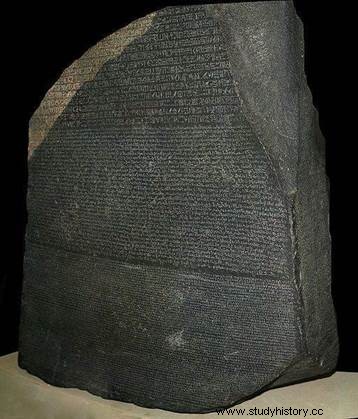 Despite his discoveries, Champollion will bear the brunt of his proximity and especially that of his brother with imperial circles . Jacques-Joseph, who during the Hundred Days was noticed by the Emperor himself (he was his secretary during his stay in Grenoble) was gradually ostracized from political and academic circles after the second Restoration. Jean-François, whose avant-garde theories and ego earned him many jealousies, suffered the same fate, and both left Grenoble for Figeac. This exile on the land of his childhood is an opportunity for Champollion to perfect his work and improve his financial situation, which has been complicated up to now.
Despite his discoveries, Champollion will bear the brunt of his proximity and especially that of his brother with imperial circles . Jacques-Joseph, who during the Hundred Days was noticed by the Emperor himself (he was his secretary during his stay in Grenoble) was gradually ostracized from political and academic circles after the second Restoration. Jean-François, whose avant-garde theories and ego earned him many jealousies, suffered the same fate, and both left Grenoble for Figeac. This exile on the land of his childhood is an opportunity for Champollion to perfect his work and improve his financial situation, which has been complicated up to now.
At the end of 1817, he managed to return to Grenoble, taking advantage of the appeasement of political repression. Although a simple librarian, he nevertheless continues to stand out both for his scientific activities and for his political opinions as an opponent of the Ultra monarchists. This earned him to leave Grenoble once again, for Paris in 1821. This year will be the year of his greatest success.
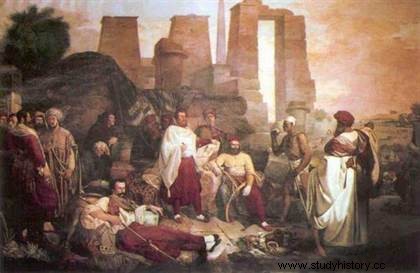 Indeed, he then managed to decipher the name of Pharaoh Ptolemy V on an inscription of the Rosetta Stone. Next comes the deciphering of Cleopatra's name on the Philae obelisk. One thing leading to another and with great reinforcements of cross-checking where intuition and logic mingle, he establishes a table of value of the different hieroglyphic signs.
Indeed, he then managed to decipher the name of Pharaoh Ptolemy V on an inscription of the Rosetta Stone. Next comes the deciphering of Cleopatra's name on the Philae obelisk. One thing leading to another and with great reinforcements of cross-checking where intuition and logic mingle, he establishes a table of value of the different hieroglyphic signs.
On September 14, 1822, at the end of exhausting work, Champollion was so convinced of having pierced the mystery of the Hieroglyphs that, overwhelmed by emotion, he suffered a mild attack (but nevertheless indicative of the fragile state of health of this workaholic). Eight days later he sent the Academy of Inscriptions and Belles-Lettres a first summary of his discoveries. A summary of the hieroglyphic system will follow in 1824.
Champollion and Egypt, a fatal passion
The 1820s would see Champollion's work gain the recognition he had long awaited. Benefiting from the support of scholars like Von Humboldt (the famous German linguist and philosopher) and political figures, he managed to help his brother finance a study trip to Italy. For his first departure outside France, Jean-François is going beyond the Alps to scour the libraries and museums but above all the Egyptian collection of the King of Piedmont-Sardinia in Turin. He unearthed a certain number of pieces there, notably from the 1799 expedition to Egypt, and accomplished a remarkable job, which earned him the interest of the Pope but also of the King of France.
In 1826 Champollion was appointed curator in charge of the Egyptian collections at the Louvre Museum. Consecration of the work of a lifetime, this function allows him to directly influence the development of nascent Egyptology. Enjoying a certain academic aura, he notably convinced King Charles X to acquire several marvels, whether it was the collection of the British consul in Egypt or an obelisk from Luxor (offered by vice -king Mehmet Ali)…which now sits on Place de la Concorde.
The founder of modern scientific Egyptology
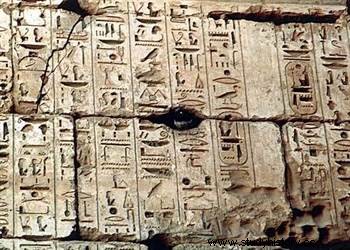 In 1828, at the peak of his career, Jean-François Champollion set sail for Egypt. After more than 20 years of theoretical work, he will be able to discover with his own eyes the monuments he has dreamed of for so long. Nevertheless, at almost 40 years old, Champollion is a man worn down by the sacrifices he has made to advance his science. Egypt at the time was a remote country, whose climate was not very successful for Europeans due to several endemic diseases. Neglecting once again his health, the Egyptologist undertook to verify in situ the validity of his theories on hieroglyphs. From his eighteen months of travel he will return with an invaluable mass of notes, documents and notebooks, but also with a chronic condition (bilharziasis?) which will eventually prevail.
In 1828, at the peak of his career, Jean-François Champollion set sail for Egypt. After more than 20 years of theoretical work, he will be able to discover with his own eyes the monuments he has dreamed of for so long. Nevertheless, at almost 40 years old, Champollion is a man worn down by the sacrifices he has made to advance his science. Egypt at the time was a remote country, whose climate was not very successful for Europeans due to several endemic diseases. Neglecting once again his health, the Egyptologist undertook to verify in situ the validity of his theories on hieroglyphs. From his eighteen months of travel he will return with an invaluable mass of notes, documents and notebooks, but also with a chronic condition (bilharziasis?) which will eventually prevail.
On his return, Champollion, elected to the Academy of Inscriptions and Belles-Lettres, took over the very first chair of Egyptian Antiquity at the Collège de France. He published four volumes of drawings and sketches relating to the monuments studied during his trip and completed his grammar and his Egyptian dictionary, a masterful synthesis of his work. However, he will not have the opportunity to have them published (his brother will take care of it). A stroke won him on March 4, 1832, at the age of 41, leaving behind him an orphan discipline that promised a bright future.
Bibliography
- Champollion by Jean Lacouture. Grasset, 1989.
- Jean-François Champollion's Egyptian Dictionary. South acts, 2000.
- Champollion and the secret of hieroglyphs. Comics, Glénat 2009.
